- home
- BAKERECIPES
BakeRecipes
Bringing real baking into your home with deliciously simple recipes.
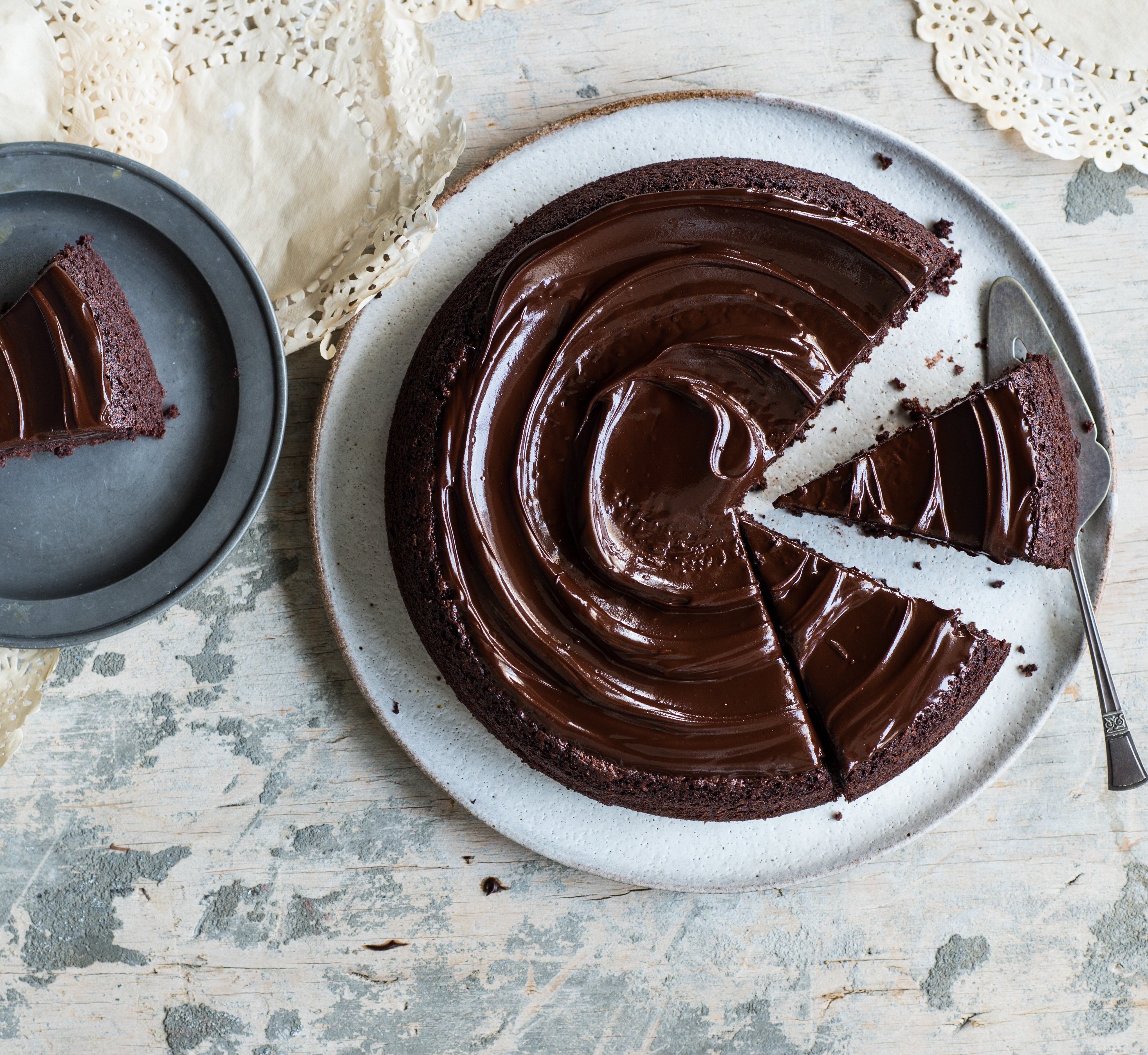
Prep 30min (+1hr cooling and 30min standing time) Bake 40minMakes 10 serves
This dairy-free, flourless number is the Jewish Passover dessert of choice.
Ingredients
75g (⅔ cup) cocoa powder, sifted
165ml (⅔ cup) boiling water
200g pecans, toasted
1 teaspoon gluten-free baking powder
4 eggs, at room temperature
220g (1 cup) raw caster sugar
200ml light olive oil, plus extra to grease
1½ teaspoons natural vanilla essence or extract
Dairy-free ganache
185g dairy-free dark chocolate, chopped
60g dairy-free spread
Method
- Preheat oven to 170°C (150°C fan-forced). Grease a 22cm springform tin with extra oil and line the base with non-stick baking paper.
- Place the cocoa in a medium bowl and gradually stir in the boiling water until smooth. Set aside to cool.
- Process the pecans in a food processor until finely ground. Transfer to a medium bowl and stir through the baking powder until evenly combined.
- Use an electric mixer with a whisk attachment to whisk the eggs, sugar, oil and vanilla on high speed for about 5 minutes or until thick and pale. Add the cocoa mixture and whisk until just combined. Add the pecan mixture and stir until just combined.
- Pour the mixture into the prepared tin and bake in preheated oven for 40 minutes or until wet crumbs cling to a skewer inserted into the centre. Cool the cake in the tin sitting on a wire rack.
- To make the dairy-free ganache, combine the chocolate and dairy-free spread in a medium heatproof bowl over a saucepan of barley simmering water (make sure the waster doesn’t touch the bottom of the bowl). Stir occasionally until the chocolate melts and the mixture is smooth. Remove the bowl form the saucepan and set aside for 10 minutes, stirring occasionally, until the ganache thickens to a thick spreadable consistency.
- Remove the cake from the tin and place on serving plate. Spoon the ganache over the cake and use the back of a spoon to spread. Set the cake aside for 30 minutes or until the ganache sets. Serve in wedges.
Baker's Tips
- This cake will keep in an airtight container at room temperature for up to 1 week.
This recipe is part of Anneka's SBS Food Bakeproof: Jewish Baking online column. For more Bakeproof columns and recipes, click here.
Photography by Alan Benson.
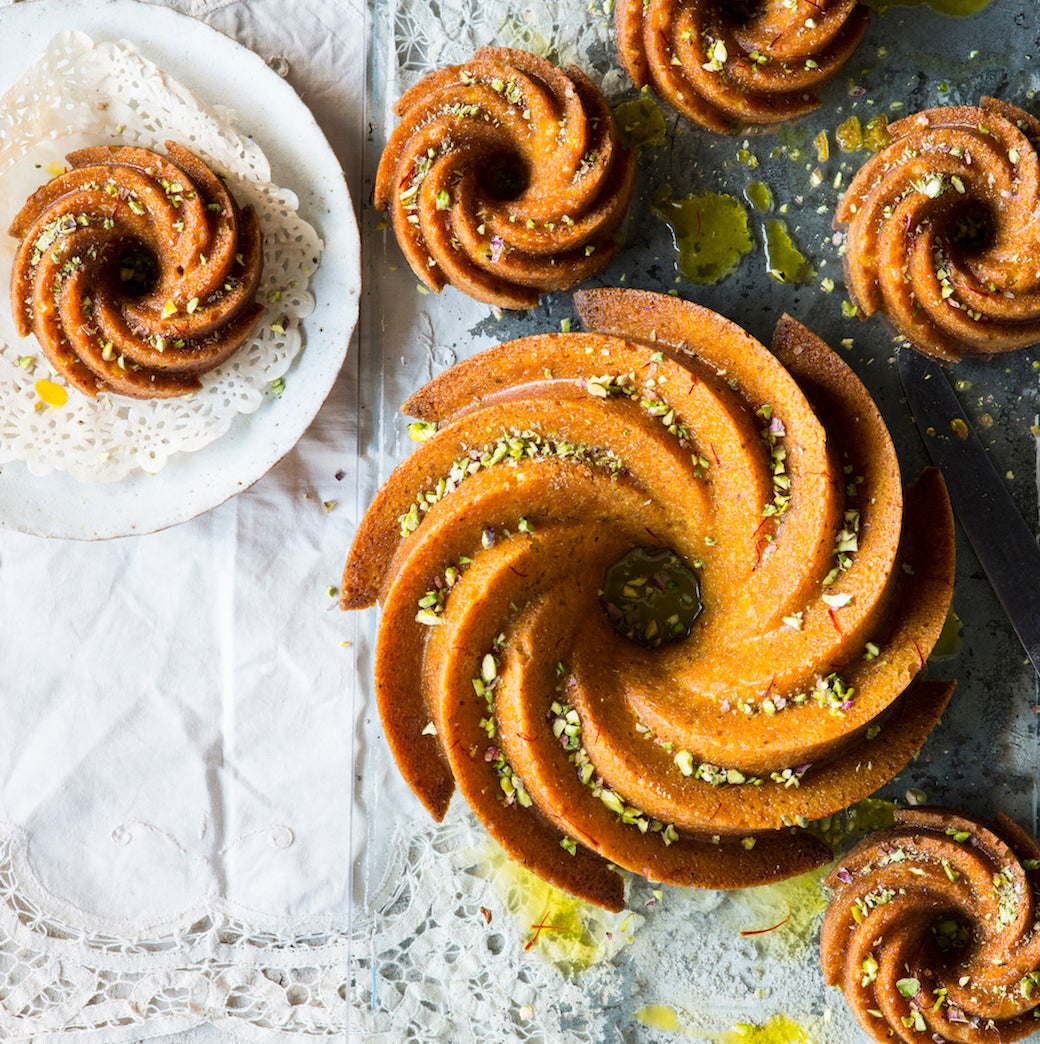
Prep 25min (+ 1hr cooling time)Bake 45minMakes 12 serves
This cake falls into that category of "less is more". The cake itself is a simple one-bowl mix whipped up in the food processor, but when baked in a decorative Bundt cake tin and infused with a flavoursome, and almost fluorescent, saffron syrup, it is one that will definitely impress.
Ingredients
15g (½oz) butter, melted
1 teaspoon plain flour
2 tablespoons unsalted pistachio kernels, toasted and chopped, to sprinkle
Orange and pistachio cake
100g (3½oz) unsalted pistachio kernels, toasted
1 orange (about 240g/8½oz), quartered, cored and seeds removed
220g (1 cup/7oz) caster sugar
125g (4½oz) salted butter, melted and cooled
2 eggs, at room temperature
185g (1¼ cups/6½oz) self-raising flour
Saffron syrup
1 large pinch saffron threads
125ml (½ cup/4fl oz) boiling water
125ml (½ cup/4fl oz) strained freshly squeezed orange juice
110g (½ cup/4oz) caster sugar
Method
- Preheat the oven to 170°C/340°F (150°C/300°F fan-forced). Combine the 15g/½oz melted butter with the 1 teaspoon plain flour and use a pastry brush to grease a 2 litre (8 cup/3.5pt) Bundt tin (see Baker's Tips).
- Place the pistachios in a food processor and process until very finely ground. Add the whole orange, sugar, butter and eggs to the food processor and process until the orange rind is finely chopped and the mixture is almost smooth. Add the self-raising flour and process briefly until just combined.
- Pour the mixture into the prepared tin. Tap the tin firmly on the benchtop 3 times to settle the mixture. Bake in preheated oven for 40-45 minutes or until a skewer inserted into the cake comes out clean. Stand the cake in the tin for 10 minutes.
- Meanwhile, place the saffron in a small dish and add about 1 tablespoon of the boiling water. Set aside to infuse. Combine the remaining boiling water, orange juice and sugar in a small saucepan and stir over low heat until the sugar dissolves. Add the saffron mixture, bring to a simmer over high heat. Reduce the heat to low and simmer for 5 minutes or until reduced slightly.
- Turn the cake onto a serving plate or cake stand with a lip. Gradually pour the hot saffron syrup over the hot cake, allowing it to soak in. Set aside and allow to cool (this will take about 1 hour). Serve sprinkled with the chopped pistachios.
Baker's Tips
- This cake will keep in an airtight container at room temperature for up to 3 days.
- I baked this cake in a Nordic Ware Heritage Bundt pan.
- You can also bake this cake as eight individual Bundts. Combine 30g (1oz) butter, melted, with 2 teaspoons plain flour and grease eight individual 250ml (1 cup/9fl oz) Bundt tins. Divide the mixture evenly among the tins and then tap them firmly on the benchtop 3 times to settle the mixture. Bake at 190°C/375°F (170°C/340°F) for 18-20 minutes or until a skewer inserted comes out clean. Stand in the tins for 5 minutes before turning onto a serving plate and pouring the syrup over. I used the Nordic Ware Heritage Bundtlette pans for these smaller Bundt cakes – each tray has 6 holes so you will have to bake the remaining two cakes separately.
This recipe is part of Anneka's SBS Food Bakeproof: Bundt Cakes online column. For more Bakeproof columns and recipes, click here.
Photography by Alan Benson.
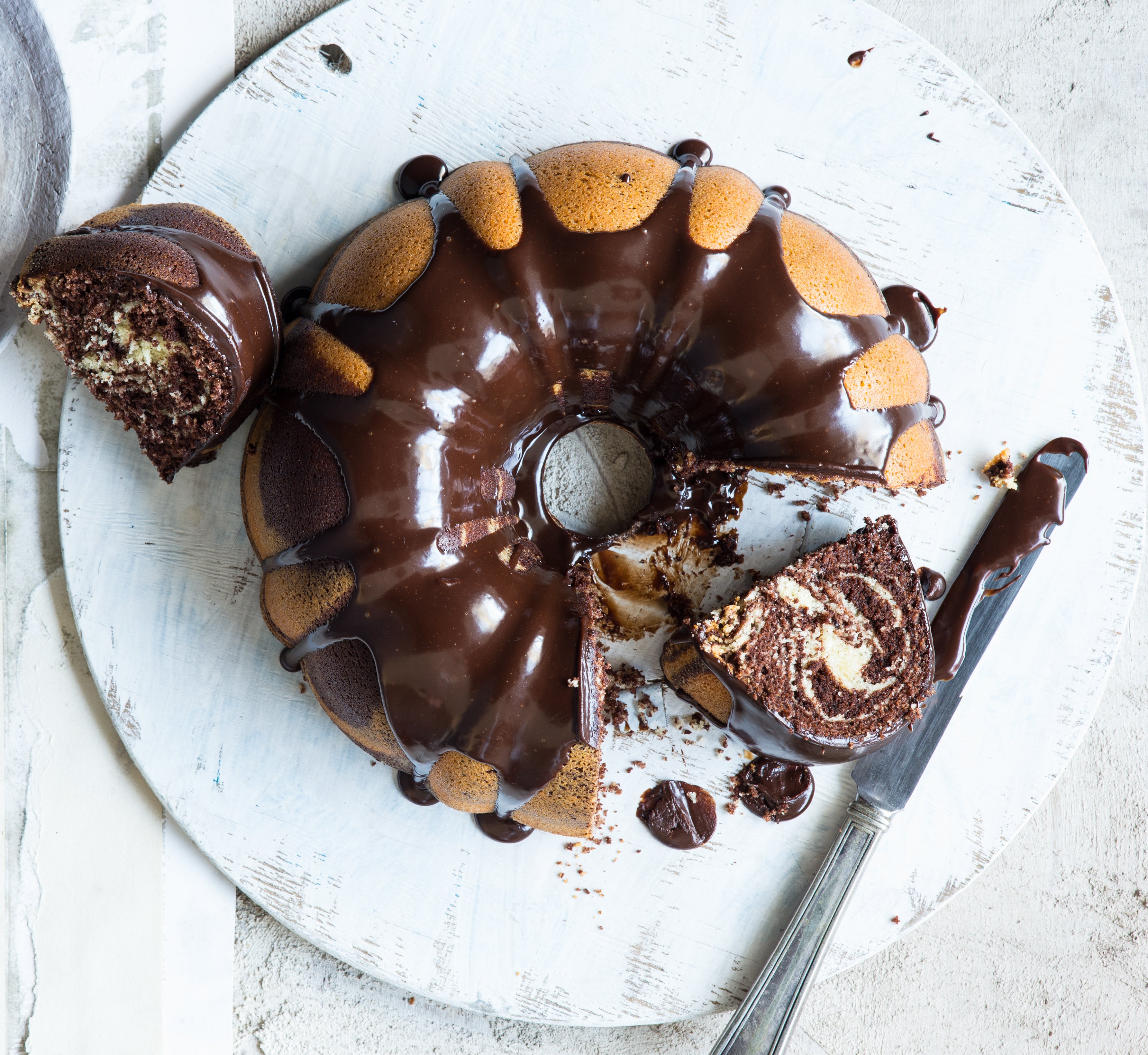
Prep 25min (+ 1hr cooling and 1hr standing time)Bake 55minMakes 12-14 serves
This is such a fun cake – the weight of alternating spoonfuls of mixture dropped on top of one another cause it to spread in the tin and create a wonderful ‘zebra’ stripped pattern that will be revealed when cut. It’s useful to remember that the smaller your spoonfuls of mixture are, the more delicate and intricate your design will be.
Ingredients
15g butter, melted
1 teaspoon plain flour
300g (2 cups) self-raising flour
70g plain flour
330g (1½ cups) caster sugar
250g salted butter, softened
4 eggs, at room temperature
185ml (¾ cup) water
2 teaspoons natural vanilla essence or extract
Cocoa mixture
55g (½ cup) cocoa powder, sifted
90ml boiling water
110g (½ cup) caster sugar
Chocolate fudge glaze
125g good-quality dark chocolate, chopped
110ml pouring (thin) cream
Method
- Preheat the oven to 170°C (150°C fan-forced). Combine the 15g melted butter with the 1 teaspoon plain flour and use a pastry brush to grease a 2 litre (8 cup) Bundt or fluted ring tin (see Baker's Tips).
- To make the cocoa mixture, place the cocoa in a medium bowl and gradually stir in the boiling water. Stir in the caster sugar and set aside.
- Put the flour, sugar, butter, eggs, water and vanilla in a large mixing bowl and use an electric mixer to beat on low speed until combined. Increase the speed to high and beat for 3-4 minutes or until paler in colour and silky smooth in texture. Transfer 2 cups (about 500g) of the cake mixture to a separate bowl. Add the cocoa mixture and use a spatula to mix until evenly combined.
- Drop a large spoonful of the vanilla mixture into the prepared cake tin. Drop a large spoonful of the cocoa mixture into the centre of the vanilla mixture. Continue dropping alternating spoonfuls of the mixtures into the tin directly on top of each other until all the mixture is used. The mixture will spread and even out as you add more, creating the ‘zebra’ pattern.
- Tap the tin firmly on the benchtop 3 times. Bake in preheated oven for 50-55 minutes or until a skewer inserted into the cake comes out clean. Stand the cake in the tin for 10 minutes before turning onto a wire rack to cool completely (this will take about 1 hour).
- To make the chocolate fudge glaze, place the chocolate in a heatproof bowl. Heat the cream in a small saucepan until almost simmering. Pour the hot cream over the chocolate and then set aside for 2 minutes. Stir until the chocolate melts and the mixture is smooth. Set aside at room temperature for 30 minutes, stirring occasionally, until thickened to a thick pouring consistency.
- Place the cake on the wire rack over a tray and pour the chocolate fudge glaze over. Set aside for 30 minutes or until the glaze sets.
Baker's Tips
- I used Baker’s Secret Fluted Tube Pan for this recipe but if you don't have this particular one, or a similar tin, you can use a greased and base-lined 24cm round cake tin instead.
- This cake will keep in an airtight container at room temperature for up to 2 days.
- The uniced cake also freezes well for up to 3 months. For the whole cake (or a portion of it), seal in an airtight container appropriate for its size before freezing. For individual pieces, wrap in plastic wrap and seal in an airtight container or freezer bag. Thaw at room temperature.
Photography by Alan Benson.
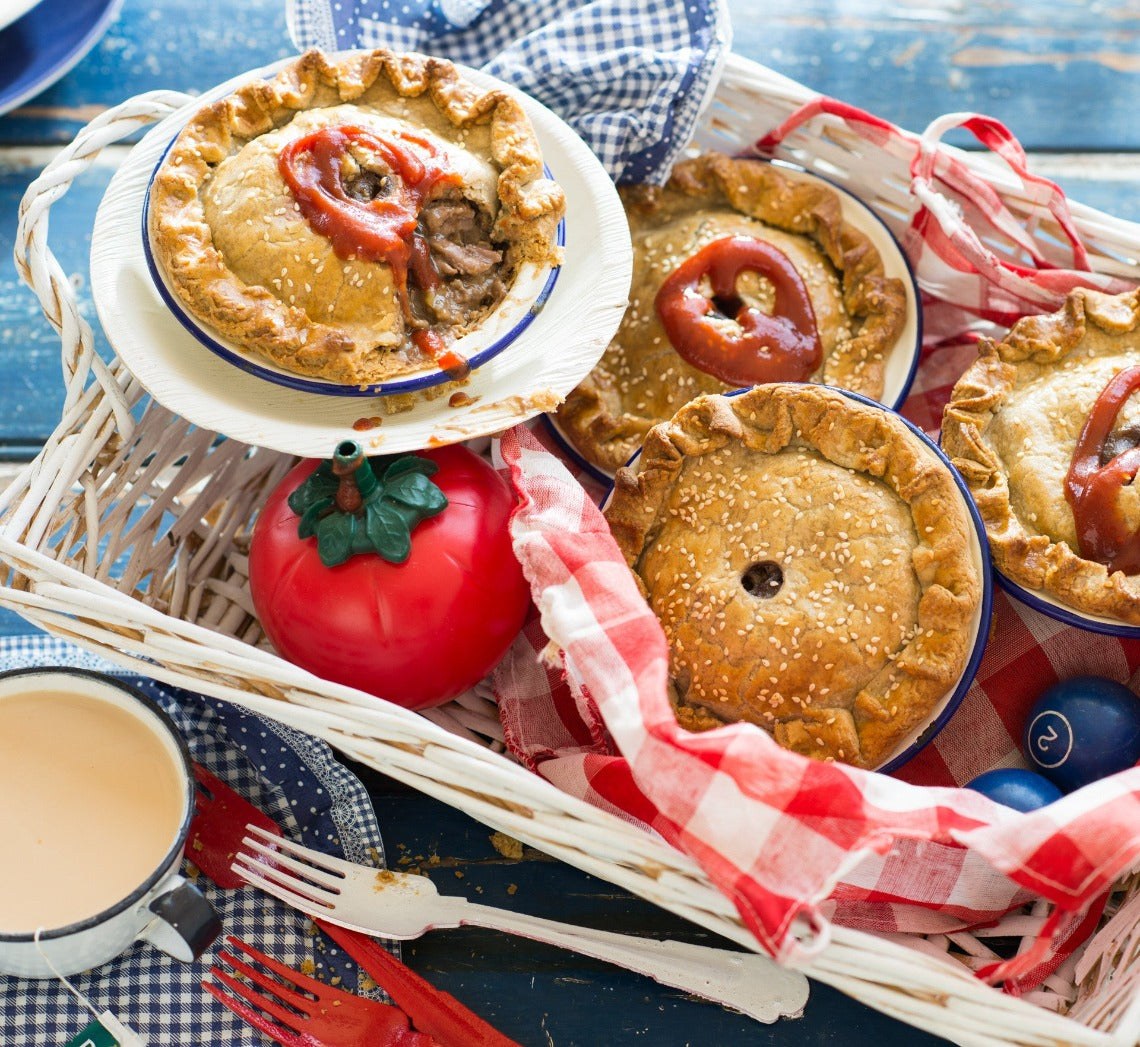
Prep 1hr (+2hr cooling and 5min standing time)Bake 2hr 30minMakes 6 serves
The addition of allspice, shiitake mushrooms, ginger and oyster sauce give these good old Aussie pies a subtle, but truly delicious, Chinese twist.
Ingredients
3 quantities shortcrust pastry (each with the addition of 1 teaspoon ground allspice added with the flour), each made separately and shaped into a disc before wrapping and chilling (see Baker's Tips)
1 egg, lightly whisked
sesame seeds, to sprinkle
Filling
1kg trimmed chuck steak, cut into 2cm chunks
35g (¼ cup) plain flour
60ml (¼ cup) peanut oil
2 small brown onions, chopped
200g shiitake mushrooms, sliced
2 garlic cloves, finely chopped
3 teaspoons finely grated ginger
250ml (1 cup) good-quality beef stock
500ml (2 cups) water
2 tablespoons oyster sauce, or to taste
Method
- Place the chuck steak in a large bowl, sprinkle with the flour and toss to coat.
- Heat 1 tablespoon of the oil in a large heavy-based saucepan over a high heat and cook half the steak chunks, stirring occasionally, for about 5 minutes or until sealed. Remove from the pan, scraping any cooked-on bits from the base, and set aside. Repeat with another tablespoon oil and the remaining steak.
- Clean the pan if necessary. Add the remaining 1 tablespoon oil, onion and shiitake mushrooms and cook over a medium-high heat, stirring occasionally, for 5 minutes or until the onion and mushrooms start to soften. Reduce the heat to medium, add the garlic and ginger and cook for a further 1 minute, stirring occasionally, or until aromatic. Return the steak to the pan with the stock, water and 1 tablespoon of the oyster sauce and bring to a simmer.
- Reduce heat to low and simmer, covered, for 30 minutes, stirring occasionally. Uncover and then simmer for a further 30 minutes to 1 hour, stirring frequently or until the meat is tender and the liquid has reduced and thickened to a thick sauce consistency. Stir in the remaining oyster sauce, taste and adjust seasoning by adding a little more oyster sauce if necessary. Transfer the mixture to a heatproof bowl, cover and place in the fridge, stirring occasionally, until cooled to room temperature (this will take about 2 hours).
- When ready to assemble the pies, preheat oven to 220°C (200°C fan-forced). Brush 6 x 10.5cm (base measurement) x 14cm (top measurement) metal or foil pie dishes. Unwrap the pastry discs and divide each into quarters. Shape a quarter into a disc and use a lightly floured rolling pin to roll the pastry on a lightly floured bench top into a round until about 3mm thick and about 15cm in diameter. Repeat with the remaining discs. Use an upturned pie dish to cut out pie lids from 6 of the rolled pastry rounds. Use the end of a 1cm piping nozzle or a small sharp knife to cut a small steam hole in the centre of each pie lid.
- Gently ease the the uncut pastry discs into the pie dishes and use your fingertips to press the pastry gently into the corners without stretching it — it will overhang the dishes slightly. Divide the steak mixture between the pastry cases to fill. Place a lid over the mixture to cover each pie, brush the edge of each lid with the whisked egg and then fold the excess pastry from the bases over the top of the lids, crimping with your fingertips or pressing with a fork together to seal. Brush the top of each pie lightly with some of the remaining egg wash and sprinkle with sesame seeds.
- Reduce the oven to 200°C (180°C fan-forced) and bake the pies in preheated oven for 45-50 minutes or until the pastry is cooked through and a deep golden. Stand the pies in the dishes for 5 minutes before turning out and serving.
Baker's Tips
- Don't be tempted to make the 3 quantities of pastry all at once. Making them separately makes the pastry easier to handle and will give you a better final result.
Photography by Alan Benson.Save
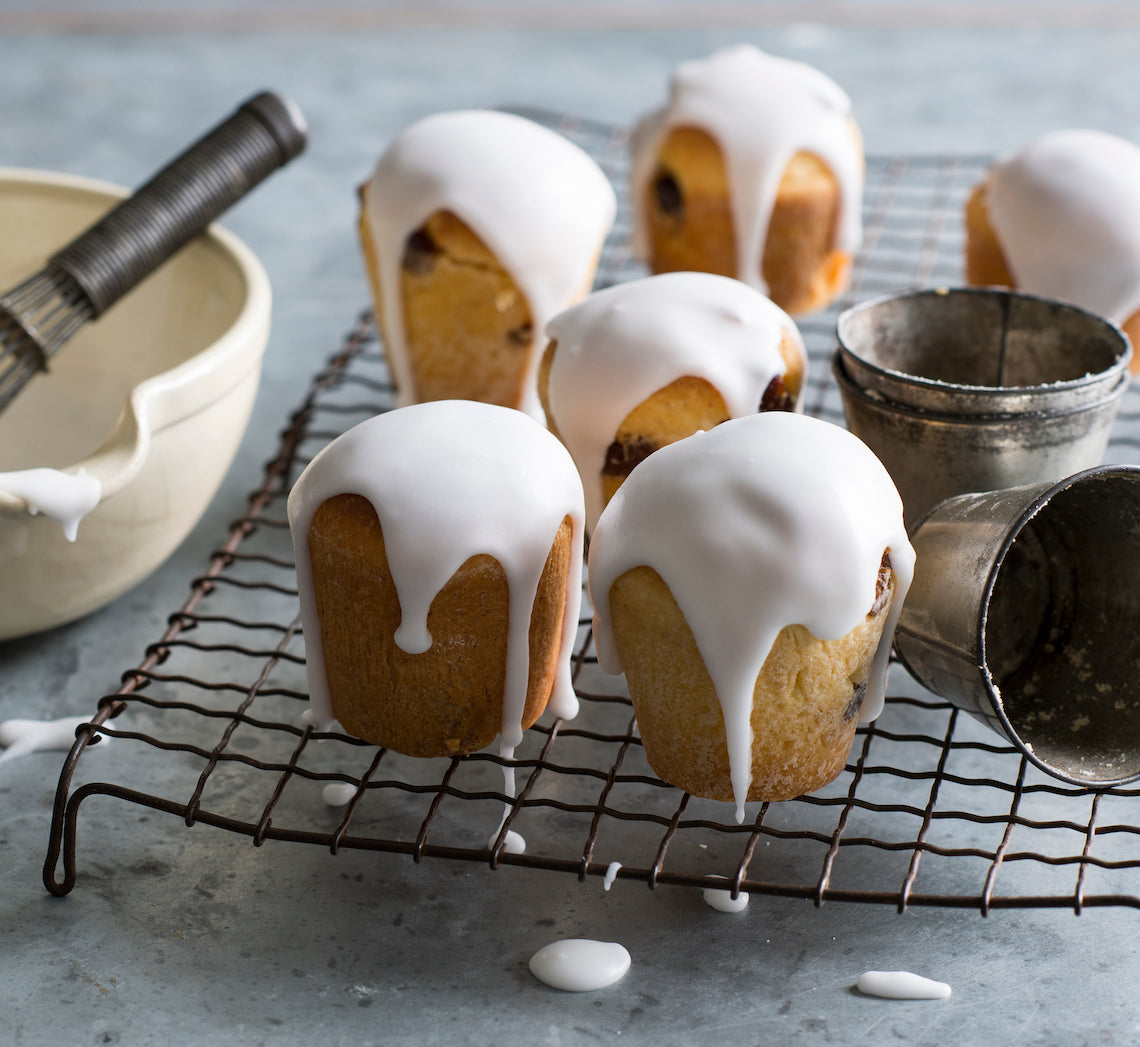
Prep 35min (+1hr 15min resting time)Bake 30minMakes 12
Many countries have their own version of this egg-rich, cake-like bread. This simple, slightly sweet, citrus-scented Ukrainian Easter one is typically baked in tall and cylindrical moulds just like Russian Kulich and Italian panettone.
Ingredients
5 egg yolks, at room temperature
1 whole egg, at room temperature
110g (½ cup) caster sugar
2 teaspoons natural vanilla essence or extract
½ teaspoon salt
185ml (¾ cup) lukewarm milk
10g (3 teaspoons) dried yeast
finely grated rind of 1 lemon
525g (3½ cups) plain flour, plus extra to dust
150g butter, cubed, at room temperature
170g (1 cup) seedless raisins
melted butter, to grease
Icing
370g (3 cups) pure icing sugar
3-4 tablespoons water
Method
- Put the egg yolks, egg, sugar, vanilla and salt in the bowl of a stand mixer and beat on high until pale and well combined. Add the milk, yeast and lemon rind and beat on low speed to combine. Gradually beat in 300g (2 cups) of the flour on low speed until combined. With the motor running gradually add the butter, a cube at a time, alternating with the remaining 225g (1½ cups) flour until a smooth, soft dough forms. Replace the beater with a dough hook and continue to knead on low speed for about 6 minutes or until very smooth and elastic. (Alternatively, turn onto a lightly floured bench and knead by hand for 10-15 minutes.) Knead in the raisins. Cover the dough in the bowl with plastic wrap and set aside in a warm draught-free place for 45 minutes or until doubled in size.
- Grease and lightly flour 12 x 125ml (½ cup) dariole moulds. Punch the centre of the dough down with your fist and turn onto a well-floured surface. Knead for 2-3 minutes or until smooth. Divide the dough into 12 equal portions, roll into balls and drop each into a prepared tin. Cover the moulds with a slightly damp tea towel and set aside in a warm draught-free place for 30 minutes or until the dough has risen to the top of the tins.
- Preheat the oven to 180°C.
- Bake the babkas in preheated oven for 28-30 minutes, covering the tops with foil if they start to brown too quickly, or until cooked when tested with a skewer and they sound hollow when tapped on the base. Stand in the moulds for 5 minutes before turning onto a wire rack to cool.
- To make the icing, put the icing sugar in a medium bowl and stir in the water to make a medium coating consistency. Spread over the tops of the babka, allowing it to drizzle down the sides. Set aside for the icing to set. Serve warm or at room temperature cut into slices.
Baker's Tips
- The babka dough can also be baked in two 9 x 19cm (base measurement) loaf tins. Grease and lightly flour as for the moulds. Divide the dough in half, roll each portion into a log about 15cm long and place in the prepared tins. Bake for 40 minutes or until cooked when tested with a skewer and they sound hollow when tapped on the base.
- This babka is best eaten the day it is made. To freeze, wrap well in plastic wrap and then seal in an airtight container or freezer bag and freeze for up to 3 months. Thaw at room temperature.
CLICK HERE for more Bakeproof recipes.
Photography by Alan Benson.
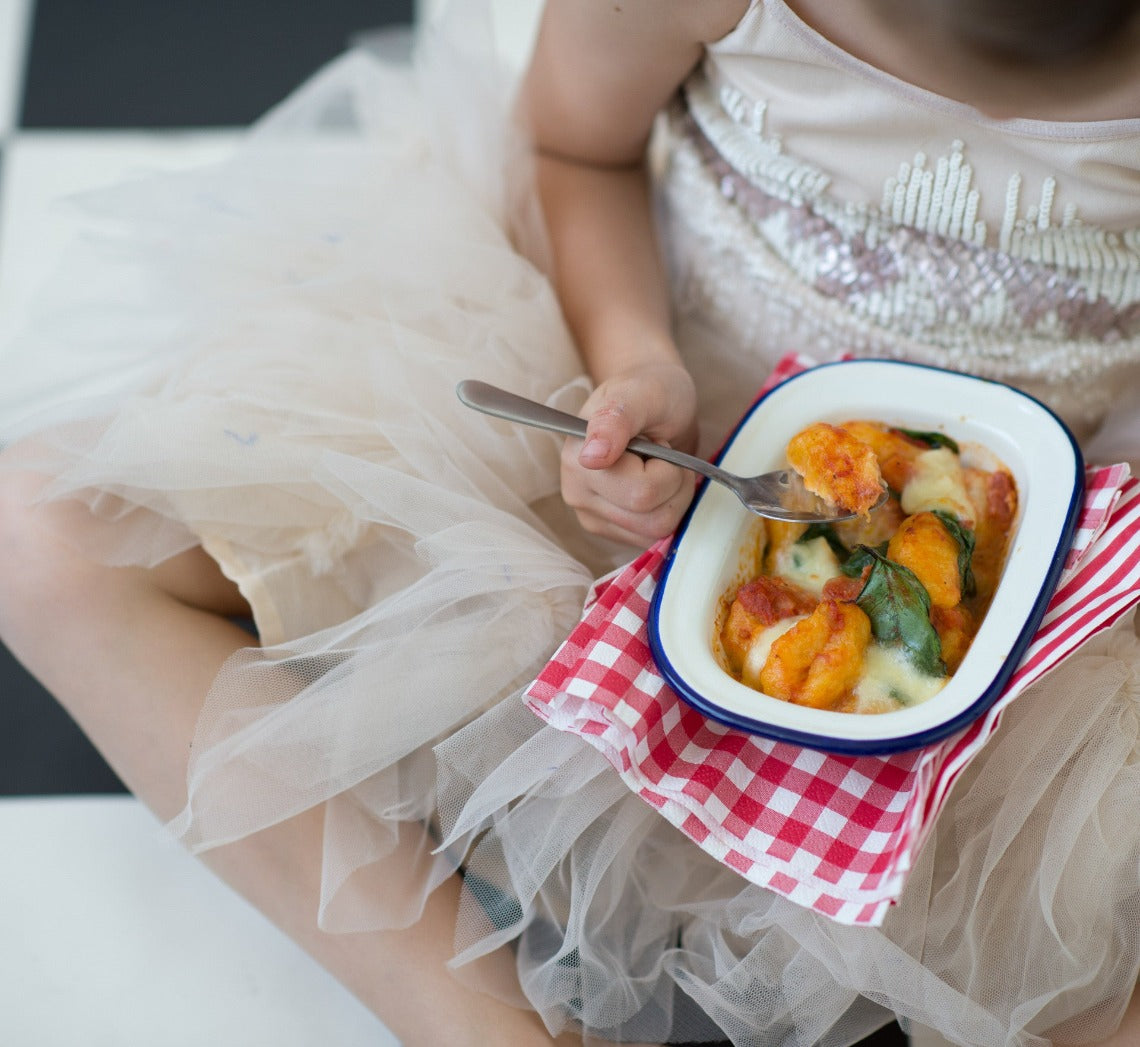
Prep 1hrBake 55minMakes 6 serves
Fun to make and scrumptious to eat, this homemade baked gnocchi combines pumpkin, tomatoes and spinach for a delicious, nutritious meal, made all the more fun by being served in individual dishes.
Ingredients
75g baby spinach
100g bocconcini, thinly sliced
Pumpkin gnocchi
350g unpeeled butternut pumpkin, deseeded and cut into 6 chunks
650g medium Desiree potatoes, unpeeled
salt and freshly ground black pepper, to taste
110g (½ cup) plain flour, plus extra to dust
Tomato sauce
100g bacon rashers, trimmed and chopped
1 garlic clove, crushed
1 x 400g can chopped tomatoes
1 teaspoon sugar
2 tablespoons pouring cream
salt and freshly ground black pepper, to taste
Method
- Preheat oven to 180°C (160°C fan-forced). Line a tray with a clean tea towel and dust lightly with flour.
- Place the pumpkin in an ovenproof dish, cover with foil and bake in preheated oven for 40 minutes or until tender when tested with a skewer. Set aside to cool slightly. Increase the oven temperature to 200°C (180°C fan-forced).
- Meanwhile, put the whole potatoes in a saucepan of water, cover with a lid and bring to the boil over medium heat. Boil for 30 minutes or until the potatoes are tender with tested with a skewer. Drain and set aside until cool enough to handle.
- Next, peel the warm potatoes, return the flesh to the dry saucepan and mash until smooth. Use a metal spoon to press a third of the potatoes through a coarse sieve or fine colander into a large bowl. Repeat with the remaining mashed potato in 2 more batches.
- Remove the pumpkin skin from the flesh and discard. Add the flesh to the potato and mash together. Season well with salt and pepper. Add the flour and use a wooden spoon and then your hands to mix to a firm but slightly sticky dough (adding a little more flour if necessary). Divide the dough into 4 equal portions and roll each out on a lightly floured bench top into a log about 2cm in diameter. Cut the logs into 2cm lengths and then roll each into a small ball. Gently roll each ball, one at a time, over the back of a lightly floured fork to form the gnocchi, placing on the tea towel-lined tray as they are finished.
- To make the tomato sauce, cook the bacon in a small saucepan over medium-high heat for 5 minutes, stirring occasionally, or until starting to colour. Add the garlic and cook for 1 minute or until aromatic. Add the tomatoes and sugar, bring to a simmer and simmer over medium-low heat for 10 minutes or until thickened slightly. Remove from the heat, stir through the cream and season with salt and pepper.
- Bring a large saucepan of salted water to the boil. Add a quarter of the gnocchi and boil for 2 minutes or until they just rise to the surface. Remove from the water immediately with a slotted spoon and place in a colander to drain well before transferring to a large bowl. Repeat with the remaining gnocchi in 3 more batches.
- Add the tomato sauce to the gnocchi with the spinach and gently stir through. Spoon the gnocchi and sauce into 6 x 250ml (1 cup) ovenproof dishes or ramekins, dividing evenly. Top with the bocconcini.
- Bake in preheated oven for 15 minutes or until bocconcini has melted and the sauce is bubbling. Remove from the oven and stand for 5 minutes before serving.
Baker's Tips
- You can also make this baked gnocchi by using 750g bought fresh gnocchi instead of making the pumpkin gnocchi.
- You can also bake this recipe in a 1.5 litre (6 cup) ovenproof dish. The baking time and temperature will be the same.
This recipe is from Anneka's SBS Food online column, Bakeproof: Kids in the Kitchen. CLICK HERE for more Bakeproof recipes.
Photography by Alan Benson.
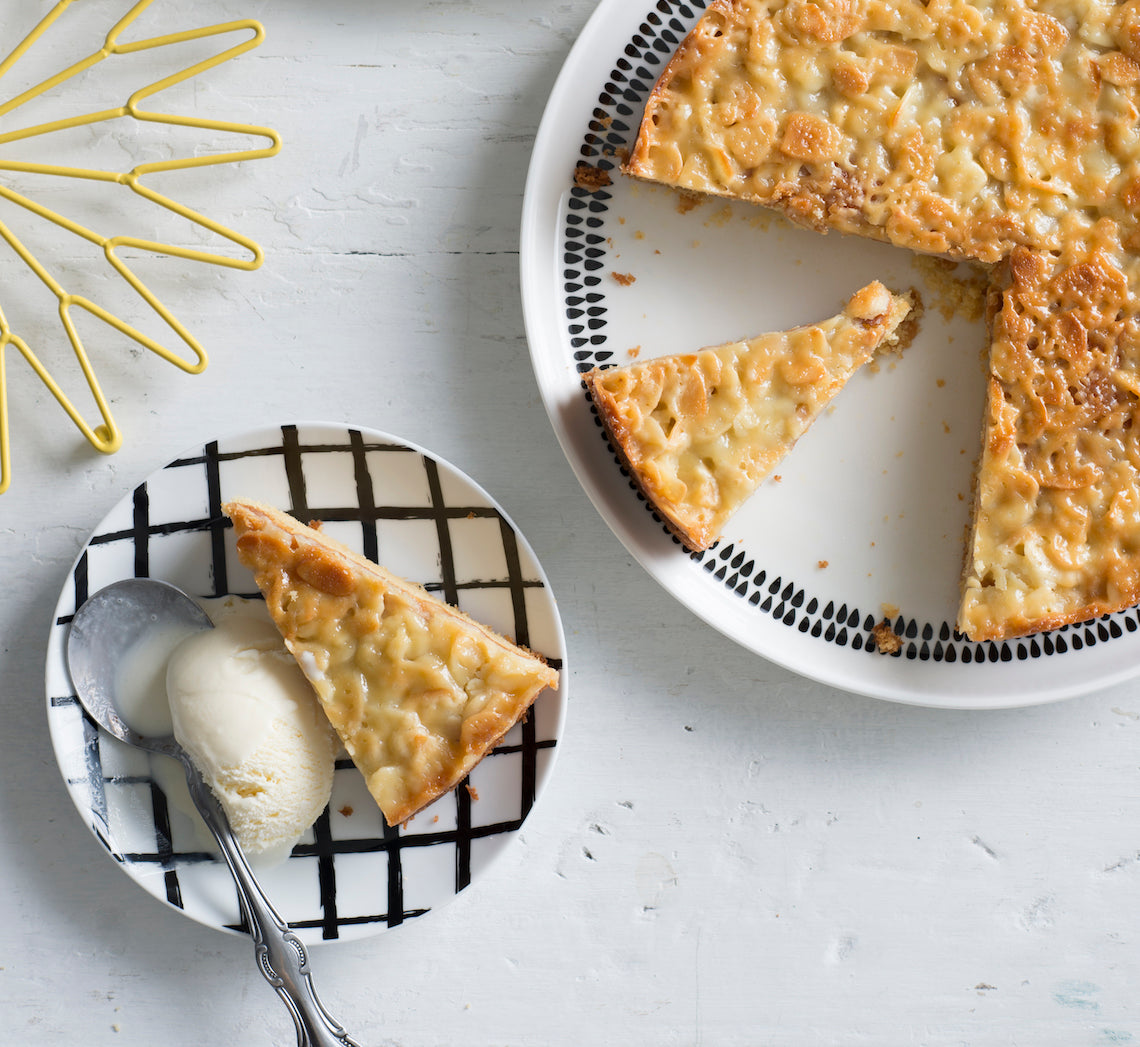
Prep 25min (+1hr 10min cooling time)Bake 40-45minMakes 8-10 serves
One of Scandinavia’s most loved cakes, both Sweden and Denmark have their own version of this wonderful cake (and, like all great cakes, the origins are unclear). A rich, buttery, moist cake topped with a crisp caramel-almond Florentine-like topping it is simply too good to care too much about its origins!
Ingredients
Melted butter, to grease
50g (5¼oz) butter, at room temperature
110g (½ cup/4oz) caster sugar
1 teaspoon natural vanilla extract or essence
2 eggs, at room temperature
150g (1 cup/5¼oz) plain flour
1 teaspoon baking powder
80ml (⅓ cup/2½fl oz) milk
Vanilla ice-cream or thick cream, to serve
Caramel almond topping
70g (2½oz) butter, cubed
75g (⅓ cup/2½oz) caster sugar
70g (⅔ cup/2½oz) flaked almonds
2½ tablespoons (50ml/1¾fl oz) pure cream
1½ tablespoons plain flour
Method
- Preheat the oven to 170°C/340°F (150°C/300°F fan-forced). Grease a 22cm/8¾in springform tin with melted butter and line the base with non-stick baking paper.
- Use an electric mixer to beat the butter, sugar and vanilla in a large bowl until pale and creamy. Add the eggs one at a time, beating well after each addition. Sift together the flour and baking powder. Add half the flour mixture to the butter mixture and beat on lowest possible speed until just combined. Add the milk and beat on lowest possible speed until just combined. Add the remaining flour mixture and beat on lowest possible speed until just combined.
- Spoon the cake mixture into the prepared tin and smooth with the back of a spoon. Place the tin on a baking tray and bake in preheated oven for 30 minutes or until almost cooked.
- Meanwhile, when the cake has been in the oven for about 20 minutes, make the topping. Combine the butter, sugar, almonds, cream and flour in a medium saucepan. Use a wooden spoon to stir over medium heat until well combined and the sugar has dissolved. Bring to a simmer and cook for 2–3 minutes or until thickened slightly.
- Remove the cake from the oven and increase the temperature to 200°C/400°F (180°C/350°F fan-forced). Quickly pour the caramel almond topping evenly over the top of the cake and then use the back of a metal spoon to spread evenly to cover the top. Return the cake immediately to the oven and bake for a further 10–15 minutes or until the cake is cooked through and the topping is golden brown.
- Remove the cake from the oven and place on a wire rack to cool for 10 minutes. Run a spatula around the outside of the cake to release the topping from the pan. Carefully remove the sides of the pan and set the cake aside for 1 hour or until cooled completely.
- Serve in wedges with ice-cream or cream.
Baker's Tip
- This cake will keep in an airtight container for up to 3 days.
This recipe is from Anneka's SBS Food online column, Bakeproof: Scandi Baking. CLICK HERE for more Bakeproof recipes.
Photography by Alan Benson.
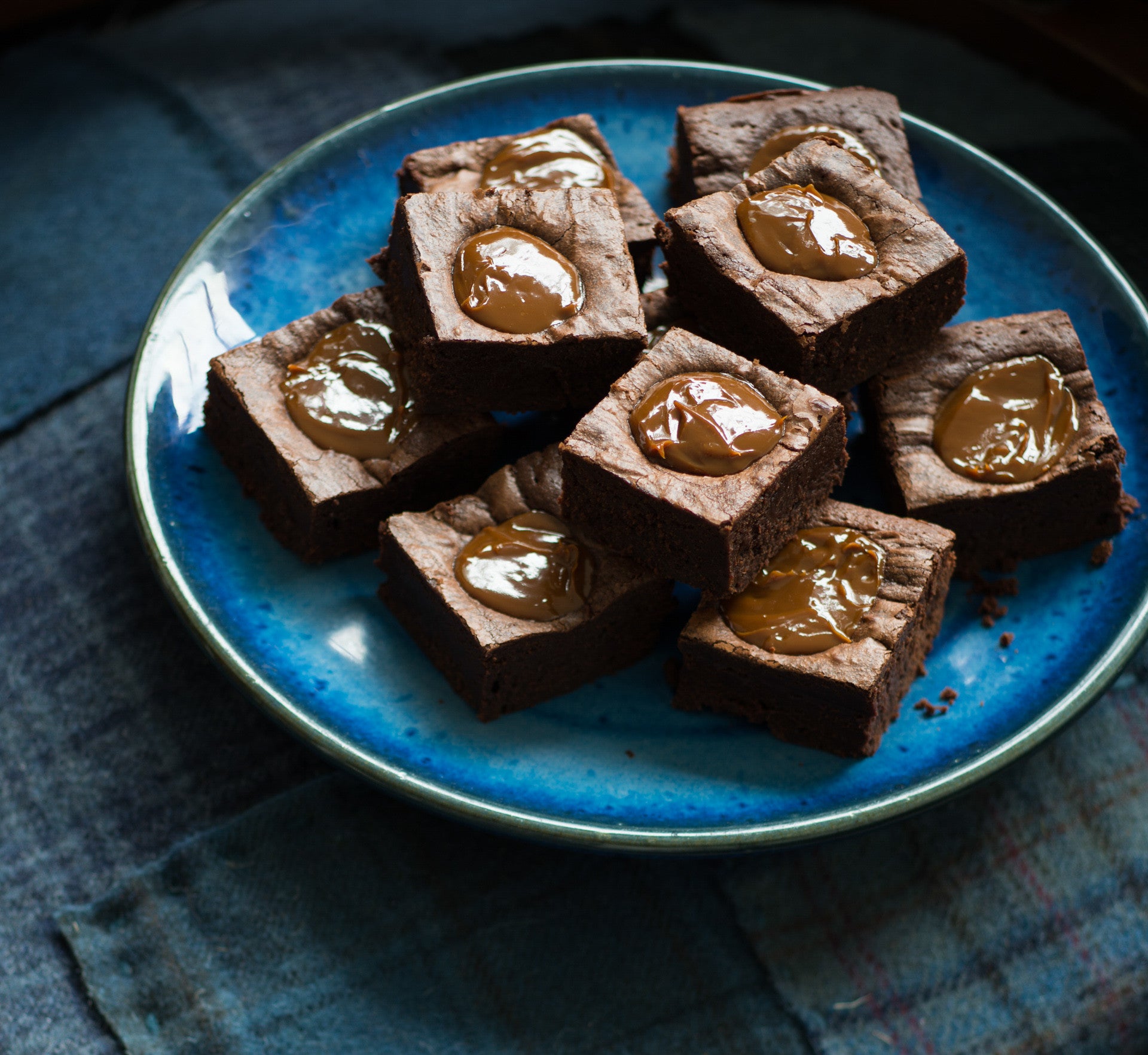
Prep 20min (+2hr cooling time)
Bake 30-35minMakes 15
Brownie lovers, take note: with every portion holding its very own generous dollop of dulce de leche, this is the brownie you have been searching for all your life! For a particularly wicked dessert, serve it drizzled with warmed extra dulce de leche and topped with a generous scoop of vanilla ice-cream.
Ingredients
Melted butter, to grease
250g (9oz) good-quality dark chocolate (45-54% cocoa), chopped
200g (7oz) salted butter, cubed
3 eggs, at room temperature, lightly whisked
165g (¾ cup, firmly packed/5¾oz) brown sugar
1½ teaspoons natural vanilla essence or extract
110g (¾ cup/4oz) plain flour
30g (¼ cup/1oz) cocoa powder
½ teaspoon baking powder
250g (9oz) jar dulce de leche
Cocoa powder or icing sugar (optional), to sprinkle
Method
- Preheat oven to 160°C/315°F (140°C/285°F fan-forced). Grease a 16cm x 26cm (6¼in x 10½in) shallow slice tin with melted butter and line the base and long sides with one piece of baking paper.
- Place the chocolate and butter in a medium heatproof bowl over a saucepan of gently simmering water (don't let the base of the bowl touch the water). Stir occasionally until chocolate and butter melt and the mixture is smooth. Remove bowl from saucepan and set aside.
- Use an electric mixer with a whisk attachment to whisk the eggs and sugar until thick and pale. Add the melted chocolate mixture and vanilla and whisk to combine.
- Sift together the flour, cocoa powder and baking powder. Add to chocolate mixture and whisk on low speed until just combined. Pour mixture into prepared tin and spread evenly with the back of a spoon.
- Dot the brownie mixture with spoonfuls of the dulche de leche, dividing evenly. Tap the tin on the benchtop to settle the mixture. Bake in preheated oven for 30-35 minutes or until moist crumbs cling to a skewer inserted in the brownie part. Remove from the oven and cool in tin on a wire rack (this will take about 2 hours).
- Remove brownie from the tin using the baking paper to lift it out. Cut into portions and sprinkle with cocoa powder or icing sugar to serve, if desired.
Baker's Tip
- These brownies will keep in an airtight container in the fridge, for up to 5 days. Serve at room temperature.
Photography by Alan Benson.
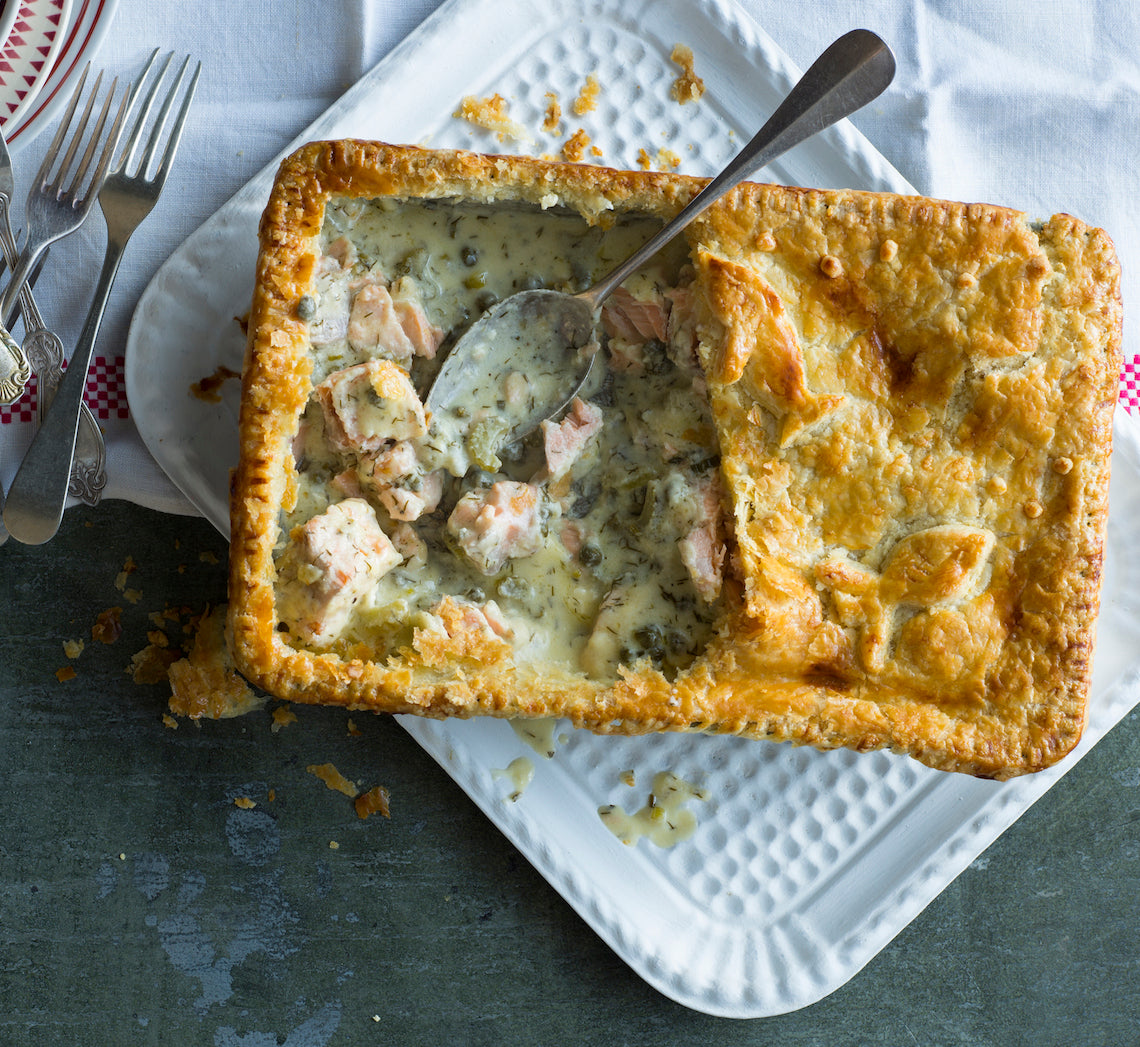
Prep 30min (+ 1hr cooling and pastry making time)Bake 45minMakes 4 serves
On a trip to Finland a few years ago it only took me a couple of meals to realise how much dill and salmon feature in the country’s wonderful cuisine. This pie is a little ode to the Fin’s favourite ingredients, all topped off with a deliciously buttery, flaky pastry.
Ingredients
40g (1½oz) salted butter2 celery stalks, trimmed and sliced
35g (¼ cup/1¼oz) plain flour
250ml (1½ cup/9fl oz) milk
125ml (½ cup/4fl oz) pouring (thin) cream
50g (½ cup/1¾oz) coarsely grated vintage cheddar
3 spring onions, trimmed and sliced
1½ tablespoons (6 teaspoons) baby capers, rinsed and drained
2 tablespoons chopped dill
1 teaspoon Dijon mustard
Salt and freshly ground black pepper, to taste
700g (1lb 8oz) skinless salmon fillets, pin-boned and cut into 3cm pieces
1 quantity Cheat's Rough Puff Pastry
1 egg yolk, lightly whisked with 2 teaspoons milk, to glaze
Method
- Melt the butter in a medium saucepan over medium heat. Add the celery and cook, stirring occasionally, for 5 minutes or until starting to soften. Add the flour and stir with a balloon whisk for about 1 minute until the mixture is bubbling and leaves the sides of the pan.
- Remove the pan from the heat and gradually stir in half the milk, stirring constantly, until smooth. Gradually add the remaining milk and cream, stirring until smooth. Return the pan to medium heat and stir constantly until the sauce thickens and starts to simmer. Reduce the heat to low and simmer, stirring frequently, for 2 minutes.
- Transfer the sauce immediately to a large heatproof bowl and stir in the cheddar, spring onions, capers, dill and mustard. Taste and season well with salt and pepper.
- Place in the fridge for about 1 hour or until cooled to room temperature.
- Preheat the oven to 200˚C/400°F (180°C/350°F fan-forced). You will need a 1.5 litre (6 cup/2pt 10fl oz) capacity ovenproof dish to cook the pie.
- When the sauce has cooled, add the salmon and stir gently to combine evenly.
- Use a lightly floured rolling pin to roll out the pastry on a lightly floured surface to the shape of the dish until about 4mm/⅛in thick. Spoon the cooled salmon mixture into the dish, then brush the edge of the dish with a little of the egg wash. Place the pastry over the filling to cover, then use a small sharp knife to run around the edge of the pie dish on a slight angle to trim the excess pastry. Use a fork to press around the edge of the dish to seal. Cut a cross in the top of the pie and then brush the pastry with a little egg wash to glaze. Decorate the top with the off-cuts of pastry, if desired, and then glaze again with the little of the egg wash.
- Place the pie on a baking tray and bake for 45 minutes or until the pastry is dark golden, crisp and cooked through. Serve straight from the oven.
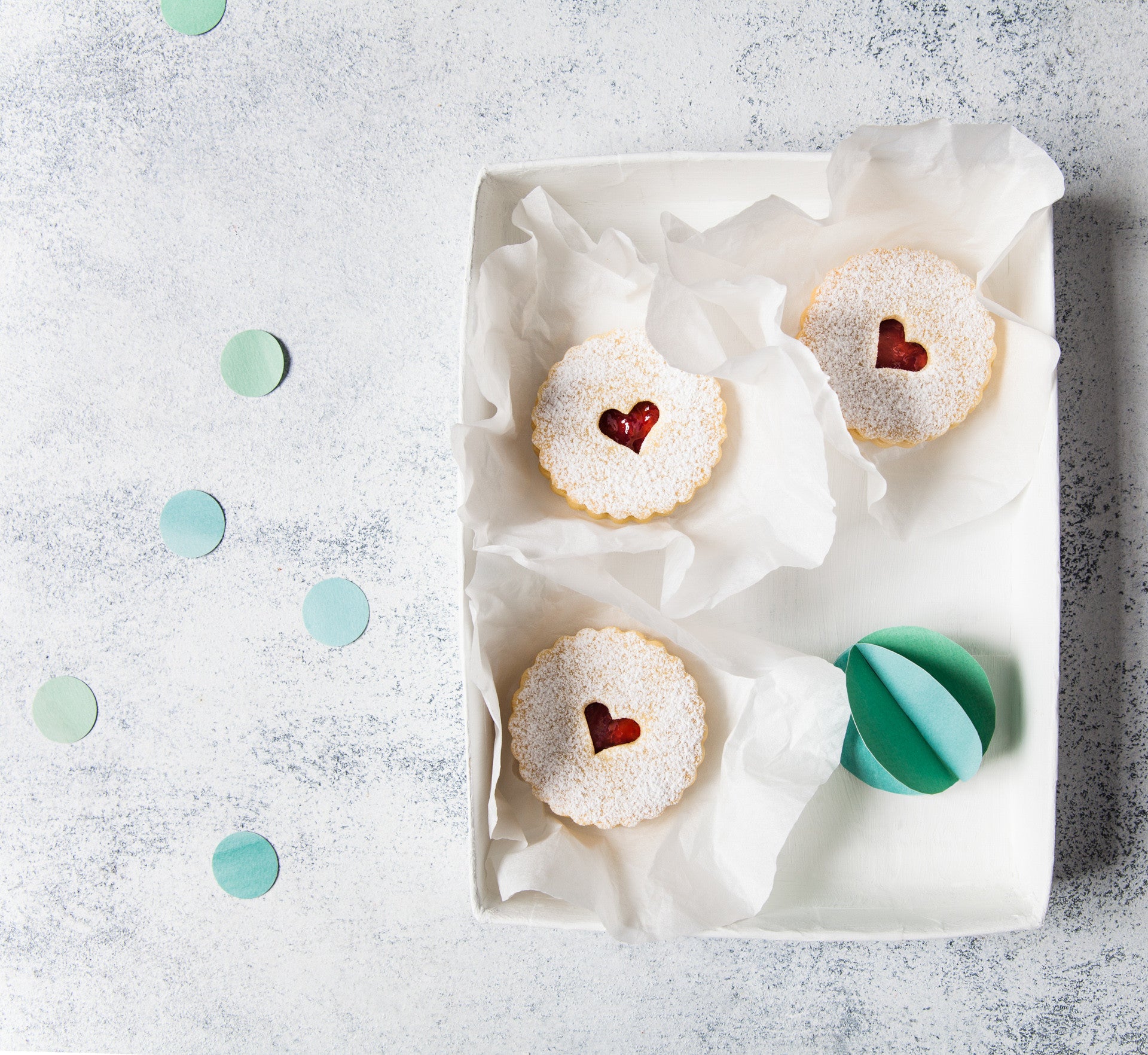
Prep 30min (+ 15min cooling and 30min chilling time)Bake 25-30minMakes about 15
These jammy, Linzer-like, buttery mouthfuls are a popular inclusion in the German Weihnachtsplätzchen (collection of traditional festive cookies) but are often claimed by the Swiss. Feel free to switch up the type of jam you use – red currant is also very traditional.
Ingredients
185g (6½oz) salted butter, at room temperature
110g (½ cup/4oz) caster sugar
1 teaspoon natural vanilla essence or extract
1 egg yolk
300g (2 cups/11¾oz) plain flour
¼ teaspoon fine salt
110g (⅓ cup/4oz) raspberry jam, warmed slightly
Icing sugar, to dust
Method
- Preheat oven to 160°C/315°F (140°C/285°F fan-forced). Line two large oven trays with non-stick baking paper.
- Use an electric mixer with a paddle attachment to beat the butter, sugar and vanilla until pale and creamy. Add the egg yolk and beat well. Sift together the flour and salt. Add to the butter mixture and beat on lowest possible speed until just combined and a soft dough forms.
- Divide the dough in half. Use a rolling pin to roll out one portion of dough between two sheets of non-stick baking paper to 5mm/¼in thick. Use a 6cm/2¼in fluted round cutter to cut out rounds of dough. Use a palette knife to transfer the rounds to the lined trays, leaving about 2cm/¾i between each to allow for spreading. Repeat with the remaining dough portion, re-rolling off-cuts, to make about 30 rounds in total. Place the trays in the fridge for 30 minutes to chill.
- Use a 2cm/¾in heart, fluted round or star-shaped cutter to cut the centre from half of the chilled cookie rounds.
- Bake for 25-30 minutes, swapping the trays halfway through baking, or until pale golden and cooked through. Cool on the trays.
- Spoon 1 teaspoon of the warm jam onto each of the cookie bases and spread to about 1cm/½in from the edge. Dust the cookie tops (with the cut-outs) generously with icing sugar. Carefully sandwich the cookies together, pressing gently to join.
Baker's Tip
- These cookies will keep in an airtight container, layered with baking paper, at room temperature for up to 1 week. Dust with icing sugar again if desired before serving.
This recipe is part of Anneka's SBS Food Bakeproof: Festive Cookies online column. For more Bakeproof columns and recipes, click here.
Photography by China Squirrel.
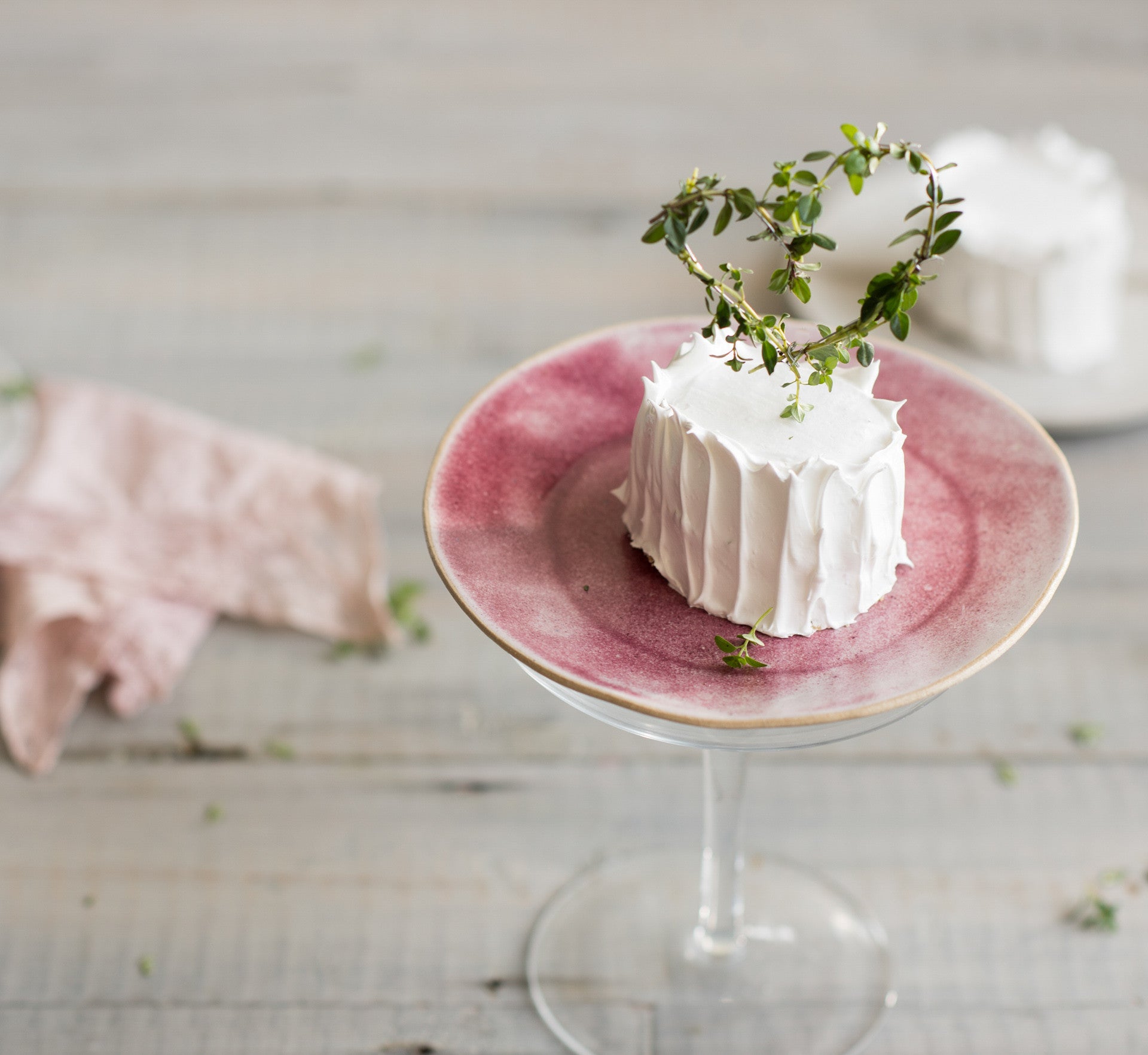
Prep 1hr (+30min cooling and 30min standing time)Bake 20minMakes 12
Hailing from the deep south of North America, Lady Baltimore cake is a classic wedding cake choice. With its simple buttercake layers, fruit and nut filling and dreamy meringue frosting, the resulting flavour combination is delightfully complex. These individual cakes are made just for one.
Ingredients
Melted butter, to grease185g butter, softened
145g (⅔ cup) caster sugar, plus 75g (⅓ cup) extra
1 teaspoon natural vanilla essence or extract
1 orange, zest finely grated
225g (1½ cups) plain flour
2 teaspoons baking powder
165ml (⅔ cup) milk
3 egg whites
Filling
45g (¼ cup) raisins, chopped45g (¼ cup) chopped dried figs
2 tablespoons brandy
40g (⅓ cup) chopped toasted walnuts
Meringue Frosting
- 3 egg whites
- 150g (⅔ cup) caster sugar
- 1 teaspoons natural vanilla essence or extract
Method
- Preheat the oven to 180°C (160°C fan-forced). Brush a 12-hole 125ml (½ cup) friand pan with melted butter to grease.
- To make the filling, combine the raisins, figs and brandy in a small saucepan and heat over low heat for 3-5 minutes or until heated through. Remove from the heat and set aside to cool.
- Use an electric mixer to beat the butter, 145g (⅔ cup) caster sugar, vanilla and orange zest, scraping down the sides of the bowl when necessary, until pale and creamy.
- Sift together the flour and baking powder. With the motor running on the lowest possible speed, beat in the flour alternately with the milk, in 2 separate batches each, until just combined.
- In a separate clean dry medium mixing bowl, use a whisk attachment to whisk the egg whites until soft peaks form. Gradually add the extra caster sugar, a spoonful at a time, and whisk on medium-high speed until thick and glossy. Use a large metal spoon or spatula to fold a large spoonful of the egg white mixture through the butter mixture until well combined. Add the remaining egg white mixture and fold until just combined. Divide the mixture evenly among the friand holes and smooth the surfaces. Bake for 20 minutes or until a skewer inserted in the the centre of the cakes comes out clean. Stand the cakes in the tin for 5 minutes before turning out onto a wire rack to cool completely.
- Meanwhile, make the meringue frosting. Choose a medium heatproof mixing bowl that sits snugly on top of a medium saucepan. Quarter-fill the saucepan with water and bring to the boil. Reduce the heat to the lowest possible setting. Put the eggwhites and sugar in the heatproof bowl and place over the simmering water. Use a spatula to stir until the sugar dissolves. (You can tell if the mixture is ready by rubbing a little between your fingers – if it still feels grainy, then continue to stir for another minute or until it no longer feels grainy.) Transfer the mixture to the bowl of an electric mixer and use a whisk attachment to whisk on high speed for 5-8 minutes or until the meringue has cooled to room temperature and is very thick and glossy. Whisk in the vanilla. Transfer two-thirds of the frosting to a bowl, cover with plastic wrap and set aside.
- To finish the filling, transfer the remaining third of the frosting to a medium bowl and fold in the chopped walnuts and the fruit mixture.
- Use a small sharp serrated knife to cut the cakes in half horizontally and trim the tops to level, if necessary. Spread a little of the filling over the bottom halves of the cakes and sandwich with the top halves, pressing down.
- Spread the reserved meringue frosting over the sides and tops of the cakes to cover, swirling as desired. Set aside for 30 minutes for the frosting to firm slightly before serving.
Baker's Tips
- These cakes will keep in an airtight container at room temperature for up to 2 days.
Photography by Alan Benson.
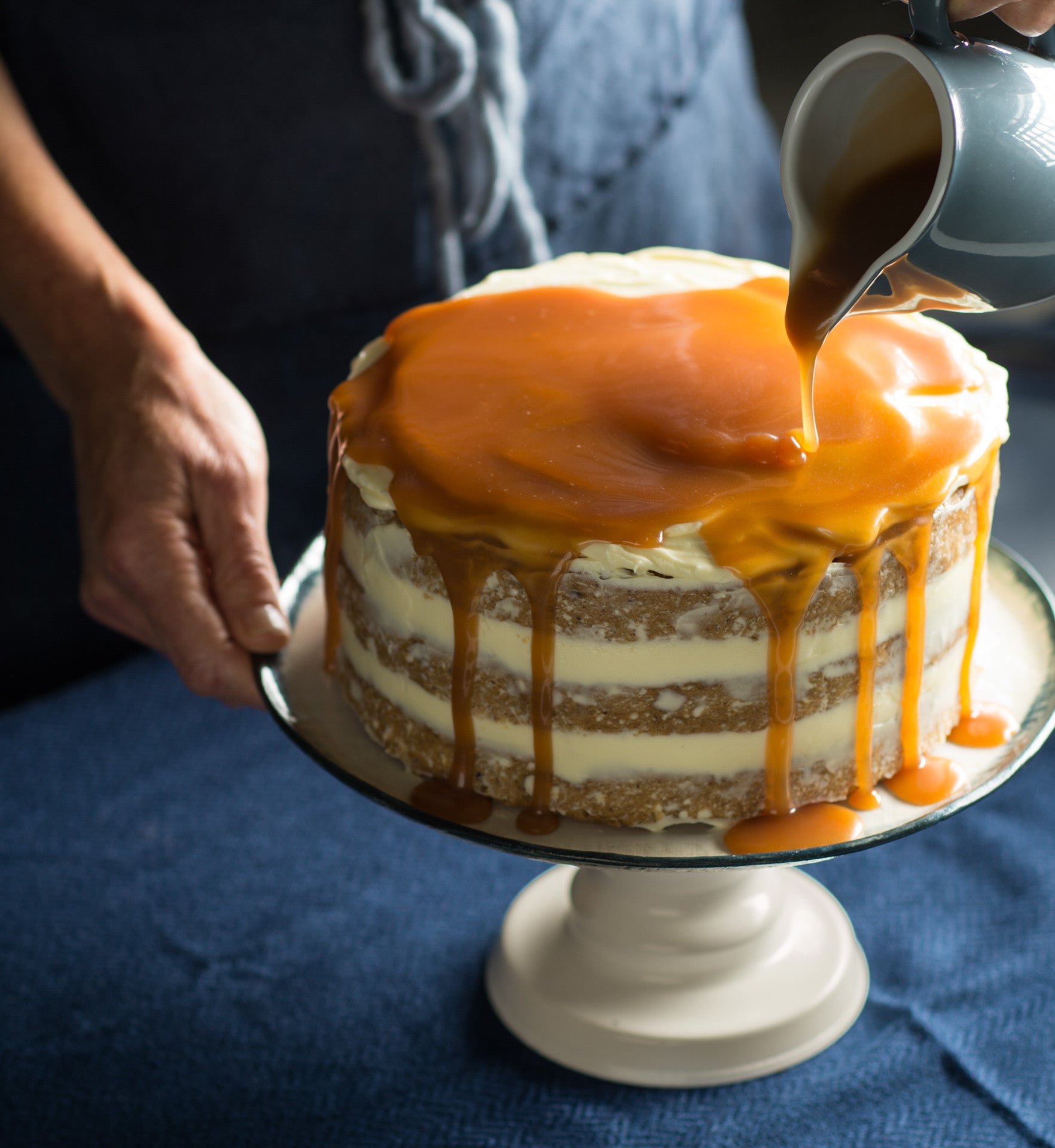
Prep 35min (+1hr cooling time)Bake 25minMakes 12 serves
Layer upon layer, this impressive cake is deceptively simple to make. What’s more, you could call it a hazelnut hummingbird cake with the added bonus of lashings of caramel. Now what’s not to love about that!
Ingredients
Banana and hazelnut cake layers
Melted butter, to grease
300g (2 cups/10½oz) plain flour
3½ teaspoons baking powder
2 teaspoons ground cinnamon
½ teaspoon ground cardamom
220g (1 cup, firmly packed/7¾oz) brown sugar
100g (3½oz) hazelnut meal
60g (⅔ cup/2oz) desiccated coconut
150g (5¼oz) salted butter, melted and cooled
3 eggs, at room temperature, lightly whisked
4 ripe medium bananas (about 200g/7oz each), mashed
2 teaspoons natural vanilla extract or essence
Caramel
165g (¾ cup/5¾oz) caster sugar
60ml (¼ cup/2fl oz) water
150ml (5fl oz) pouring cream
30g (1oz) salted butter, cubed
Cream cheese frosting
250g (9oz) cream cheese, cubed, at room temperature
80g (2¾oz) salted butter, cubed, at room temperature
1 teaspoon natural vanilla essence or extract
185g (1½ cups/6½oz) icing sugar
Method
- To make the cake layers, preheat the oven to 180°C/350°F (160°C/315°F fan-forced). Brush three shallow 20cm/8in round cake tins with the melted butter to grease and line the bases with non-stick baking paper.
- Sift together the flour, baking powder, cinnamon and cardamom into a large bowl. Stir in the brown sugar, hazelnut meal and coconut and stir with a wooden spoon to combine, breaking up any lumps. Make a well in the centre. Use a fork to whisk together the butter, eggs, banana and vanilla until well combined. Add to the dry ingredients and use a spatula or large metal spoon to fold together until just combined.
- Divide the cake mixture evenly among the prepared cake tins, smoothing the surface with the back of a spoon. Bake in preheated oven for 25 minutes, swapping the tins around halfway through baking, until pale golden and a skewer inserted into the centre of the cakes comes out clean. Stand the cakes in the tins for 5 minutes before transferring to wire racks to cool.
- Meanwhile, to make the Caramel, combine the caster sugar and water in a small saucepan and use a wooden spoon to stir over low heat until the sugar dissolves. Increase the heat to medium and bring to the boil. Boil without stirring for about 10 minutes, brushing down the side of the pan with a pastry brush dipped in water to dissolve any sugar crystals, until the mixture turns a deep caramel. Remove immediately from the heat and carefully add the cream and butter. Stir with a wooden spoon until well combined and the caramel is smooth. Return the saucepan to a medium heat if any lumps remain to dissolve them, stirring constantly. Brush a little of the hot caramel over the warm cakes.
- Pour the Caramel into a heatproof bowl or jug and set aside to cool, stirring occasionally this will take about 1 hour).
- Meanwhile to make the Cream Cheese Frosting, use an electric mixer to beat the cream cheese, butter and vanilla until well combined and creamy. With the mixer running, gradually beat in the icing sugar until well combined and smooth. Cover and set aside in a cool spot (but not in the fridge).
- To assemble the cake, spread about ½ cup of the cream cheese frosting over the top of one of the cake layers. Top with another cake layer, another ½ cup frosting and the remaining cake layer. Spread a thin layer of frosting around the outside of the cake so that the cake layers show through. Spread the remaining frosting on top. Pour a generous amount of the caramel over the top of the cake, allowing it to drizzle down the sides. Serve in wedges with the remaining caramel passed separately, if desired.
Baker's Tip
- This cake will keep in an airtight container in the fridge for up to 3 days. Stand at room temperature for 30 minutes before serving.
Photography by Alan Benson.






